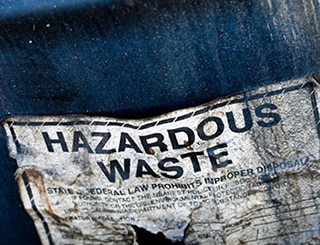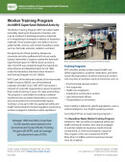Introduction
Hazardous Material/Waste
Hazardous wastes are discarded materials with properties that make them potentially harmful to human health or the environment. Hazardous wastes can include things such as chemicals, heavy metals, or substances generated as byproducts during commercial manufacturing processes, as well as discarded household products like paint thinners, cleaning fluids, and old batteries. Hazardous wastes can be in the form of liquids, solids, contained gases, or sludges. Much of this hazardous material is stored in landfills or other containment areas. If these hazardous waste sites are not properly designed or managed, their contents can be released into the surrounding environment, posing a threat to public health.
To address this issue, the NIEHS has created a Hazardous Waste Worker Training Program (HWWTP) to support the safety and health of workers engaged in activities related to hazardous waste and chemical emergency response.
What is NIEHS Doing?
NIEHS Research Efforts
- 15th Report on Carcinogens - A congressionally mandated, science-based, public health document that NTP prepares for the HHS Secretary. This cumulative report currently includes 248 listings of agents, substances, mixtures, and exposure circumstances that are known or reasonably anticipated to cause cancer in humans.
- Auto Shop Waste: How to Reduce It and What to Do with It! (330KB) - From grantee The South Valley Clean Environment Campaign
- Biomarkers of Exposure to Hazardous Substances - Using chromatographic, biosensor and cell based technologies, researchers will determine the fate and transport of hazardous materials in ground water, surface water, and air as they move from toxic waste sites.
- Disaster Preparedness & Response - The NIEHS Worker Training Program (WTP) has developed a number of training tools and other resources to assist awardees and program stakeholders in their disaster preparedness and response training efforts. Resources in this section are organized by disaster type.
- GuLFSTUDY - The GuLF STUDY (Gulf Long-term Follow-up Study) is a health study for individuals who helped with the oil spill response and clean-up, took training, signed up to work, or were sent to the Gulf to help in some way after the Deepwater Horizon disaster. The National Institute of Environmental Health Sciences (NIEHS) is leading this research with the support of many local community groups. The study is funded by the Intramural Program of the NIEHS and the National Institutes of Health (NIH) Common Fund.
- National Clearinghouse for Worker Safety & Health Training - The National Clearinghouse for Worker Safety and Health Training is a national resource for hazardous waste worker curricula, technical reports, and weekly news on hazardous materials, waste operations, and emergency response. Funded by the NIEHS Worker Training Program (WTP), the National Clearinghouse provides technical assistance to WTP staff, program awardees, and the general public.
- Oil Spills - NIEHS Worker Training Program (WTP) awardees have provided resources, trainers, and subject matter expertise during many oil spill response and related cleanup operations. The following resources provide health and safety information for workers involved in oil spill response and cleanup activities
Further Reading
Stories from the Environmental Factor (NIEHS Newsletter)
Fact Sheets
Worker Training Program
- Hazardous Waste Cleanup Focus of Federal Roundtable (June 2021)
- Small Business Commercializes Technology With New Grant (November 2020)
Additional Resources
- Entrenamiento de 8 Horas Sobre Salud y Seguridad para Trabajadores de Desperdicios Tóxicos (633KB)
- Mutagen: Talking Glossary of Genetic Terms - Designed to help learners at any level better understand genetic terms.
- ToxFAQs - This Agency for Toxic Substances and Disease Registry website provides answers to Frequently Asked Questions about contaminants found at hazardous waste sites. The FAQs explain what the substance is, methods of exposure to the substance and how it affects the environment and human health.
Related Health Topics
This content is available to use on your website.
Please visit NIEHS Syndication to get started.



